Organizational Training: Team Building, Conflict Resolution, and Dealing with Difficult People
VerifiedAdded on 2023/06/12
|7
|1784
|209
AI Summary
This article discusses the importance of team building, conflict resolution, and dealing with difficult people in organizational training. It also provides insights on how to approach different situations in the workplace.
Contribute Materials
Your contribution can guide someone’s learning journey. Share your
documents today.
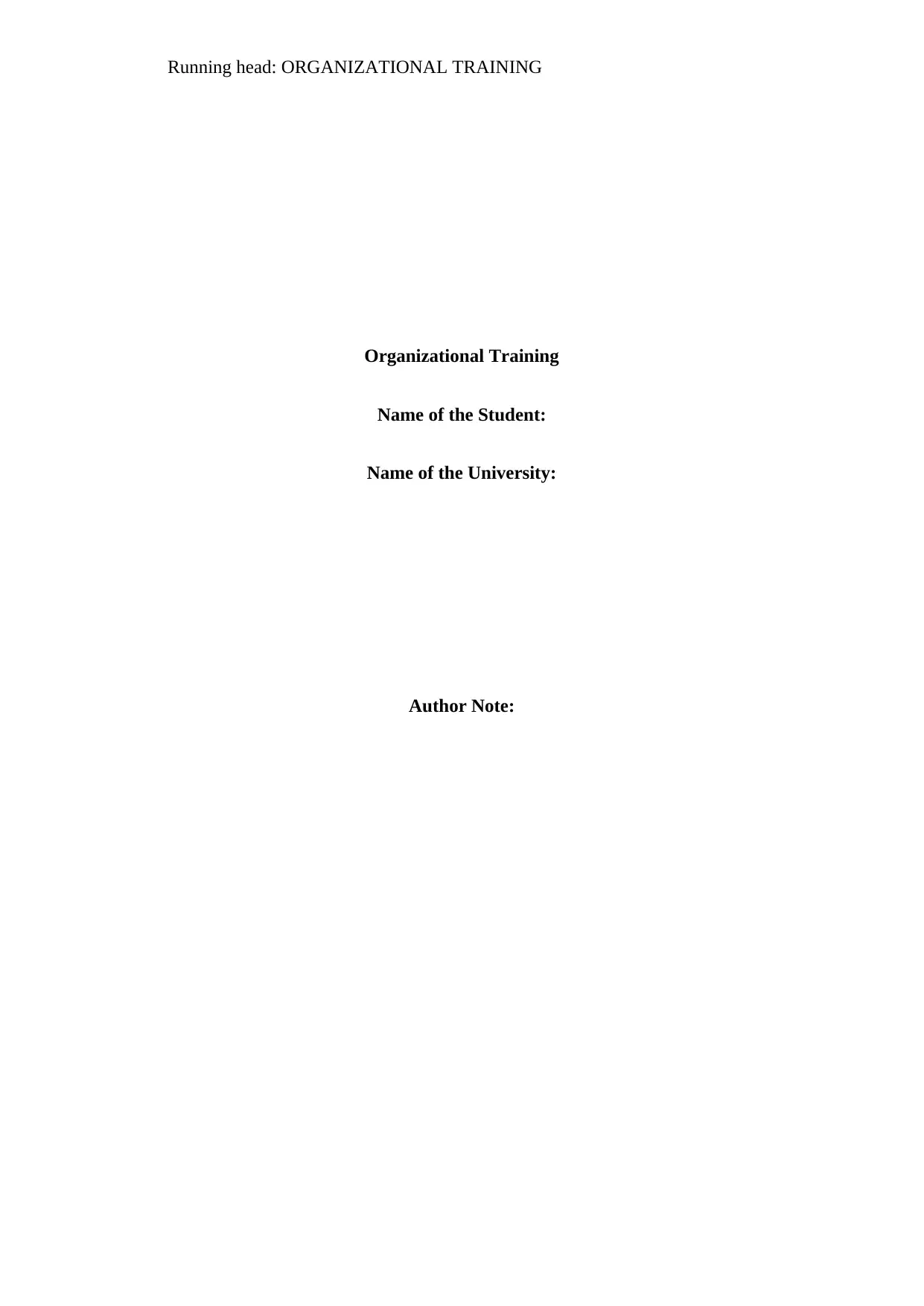
Running head: ORGANIZATIONAL TRAINING
Organizational Training
Name of the Student:
Name of the University:
Author Note:
Organizational Training
Name of the Student:
Name of the University:
Author Note:
Secure Best Marks with AI Grader
Need help grading? Try our AI Grader for instant feedback on your assignments.
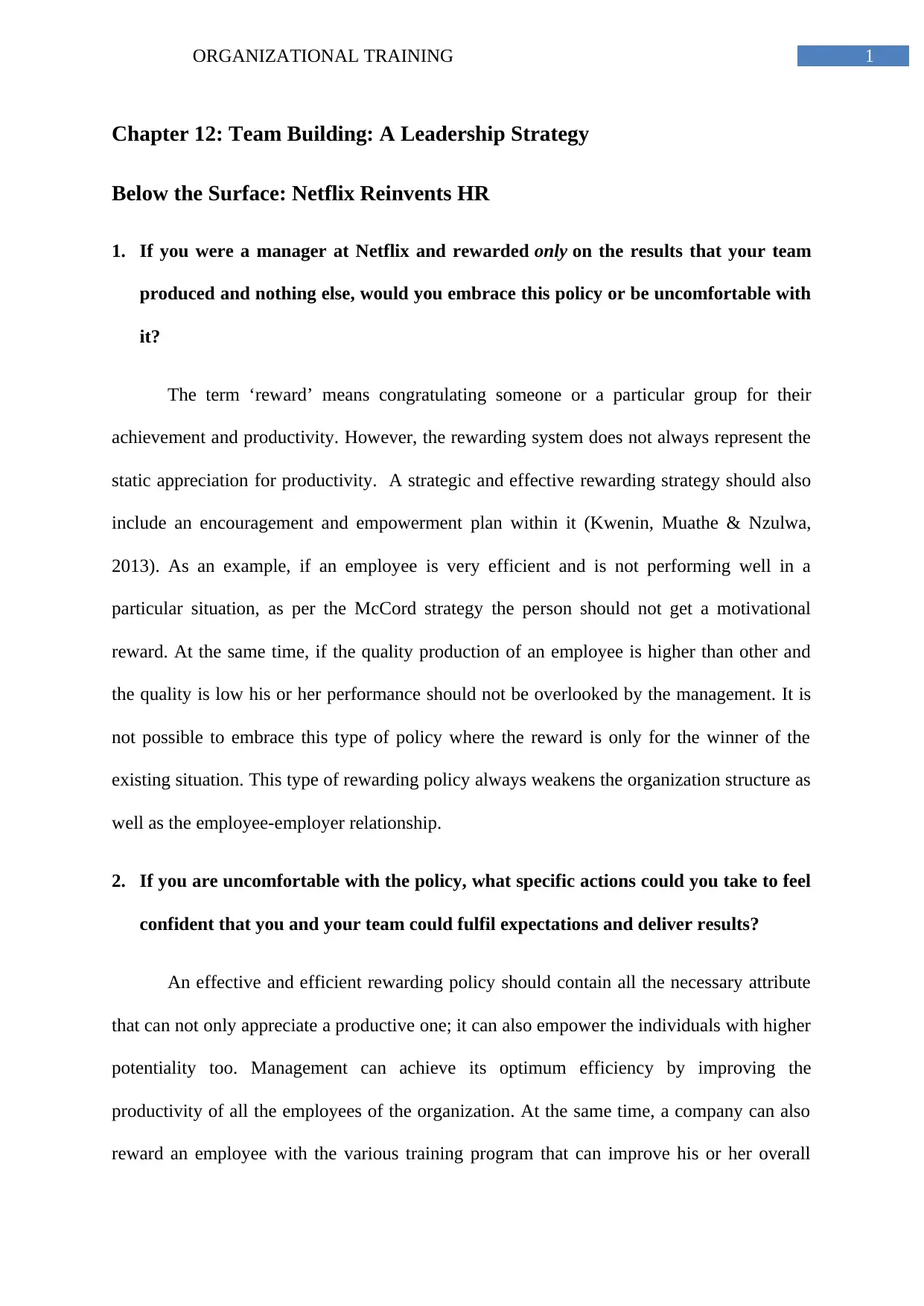
1ORGANIZATIONAL TRAINING
Chapter 12: Team Building: A Leadership Strategy
Below the Surface: Netflix Reinvents HR
1. If you were a manager at Netflix and rewarded only on the results that your team
produced and nothing else, would you embrace this policy or be uncomfortable with
it?
The term ‘reward’ means congratulating someone or a particular group for their
achievement and productivity. However, the rewarding system does not always represent the
static appreciation for productivity. A strategic and effective rewarding strategy should also
include an encouragement and empowerment plan within it (Kwenin, Muathe & Nzulwa,
2013). As an example, if an employee is very efficient and is not performing well in a
particular situation, as per the McCord strategy the person should not get a motivational
reward. At the same time, if the quality production of an employee is higher than other and
the quality is low his or her performance should not be overlooked by the management. It is
not possible to embrace this type of policy where the reward is only for the winner of the
existing situation. This type of rewarding policy always weakens the organization structure as
well as the employee-employer relationship.
2. If you are uncomfortable with the policy, what specific actions could you take to feel
confident that you and your team could fulfil expectations and deliver results?
An effective and efficient rewarding policy should contain all the necessary attribute
that can not only appreciate a productive one; it can also empower the individuals with higher
potentiality too. Management can achieve its optimum efficiency by improving the
productivity of all the employees of the organization. At the same time, a company can also
reward an employee with the various training program that can improve his or her overall
Chapter 12: Team Building: A Leadership Strategy
Below the Surface: Netflix Reinvents HR
1. If you were a manager at Netflix and rewarded only on the results that your team
produced and nothing else, would you embrace this policy or be uncomfortable with
it?
The term ‘reward’ means congratulating someone or a particular group for their
achievement and productivity. However, the rewarding system does not always represent the
static appreciation for productivity. A strategic and effective rewarding strategy should also
include an encouragement and empowerment plan within it (Kwenin, Muathe & Nzulwa,
2013). As an example, if an employee is very efficient and is not performing well in a
particular situation, as per the McCord strategy the person should not get a motivational
reward. At the same time, if the quality production of an employee is higher than other and
the quality is low his or her performance should not be overlooked by the management. It is
not possible to embrace this type of policy where the reward is only for the winner of the
existing situation. This type of rewarding policy always weakens the organization structure as
well as the employee-employer relationship.
2. If you are uncomfortable with the policy, what specific actions could you take to feel
confident that you and your team could fulfil expectations and deliver results?
An effective and efficient rewarding policy should contain all the necessary attribute
that can not only appreciate a productive one; it can also empower the individuals with higher
potentiality too. Management can achieve its optimum efficiency by improving the
productivity of all the employees of the organization. At the same time, a company can also
reward an employee with the various training program that can improve his or her overall

2ORGANIZATIONAL TRAINING
performance (Bryant & Allen, 2013). At the same time, tolerance is another effective role of
the management where the employee would not be judged per the recent performance level.
Therefore, the rewarding policy of the business can be more effective if the selection of the
potential employee as well as encouragement and empowerment are incorporated within the
HRM.
3. As a manager, how much time do you think you might take off during a year?
Explain your rationale.
Being a manager, it can be said that there should be some restriction about maximum
off that can be taken by any employee irrespective of their designation, experience or
expertise. The leave policy should be design as per the work strength and workforce
productivity of the organisation (King et al., 2012). Considering the satisfactory productivity
level of Netflix, the management should incorporate both casual and sick leave opportunities
for the employees. Up to 24 casual leave should be given in a year along with the 5 sick
leaves. However, expiration of these leaves should be regulated by the management of
Netflix.
4. As a manager, you have an employee who wants to take off 25 days in a row (more
than 30 days requires a meeting with HR) and then the same employee says he
would like to take another two-week vacation six months later. How would you
respond to him? How would you respond to other team members who say they will
have issues covering for him during that time?
In order to maintain the team performance the regular presence of each member is
chief concerns, however, if an employee wants to take leave for several days and does not
exceed his or her deserved leave count, he or she can be considered for once. At the same
time, the team members should also prepare for his or her absence when they have to cover
performance (Bryant & Allen, 2013). At the same time, tolerance is another effective role of
the management where the employee would not be judged per the recent performance level.
Therefore, the rewarding policy of the business can be more effective if the selection of the
potential employee as well as encouragement and empowerment are incorporated within the
HRM.
3. As a manager, how much time do you think you might take off during a year?
Explain your rationale.
Being a manager, it can be said that there should be some restriction about maximum
off that can be taken by any employee irrespective of their designation, experience or
expertise. The leave policy should be design as per the work strength and workforce
productivity of the organisation (King et al., 2012). Considering the satisfactory productivity
level of Netflix, the management should incorporate both casual and sick leave opportunities
for the employees. Up to 24 casual leave should be given in a year along with the 5 sick
leaves. However, expiration of these leaves should be regulated by the management of
Netflix.
4. As a manager, you have an employee who wants to take off 25 days in a row (more
than 30 days requires a meeting with HR) and then the same employee says he
would like to take another two-week vacation six months later. How would you
respond to him? How would you respond to other team members who say they will
have issues covering for him during that time?
In order to maintain the team performance the regular presence of each member is
chief concerns, however, if an employee wants to take leave for several days and does not
exceed his or her deserved leave count, he or she can be considered for once. At the same
time, the team members should also prepare for his or her absence when they have to cover
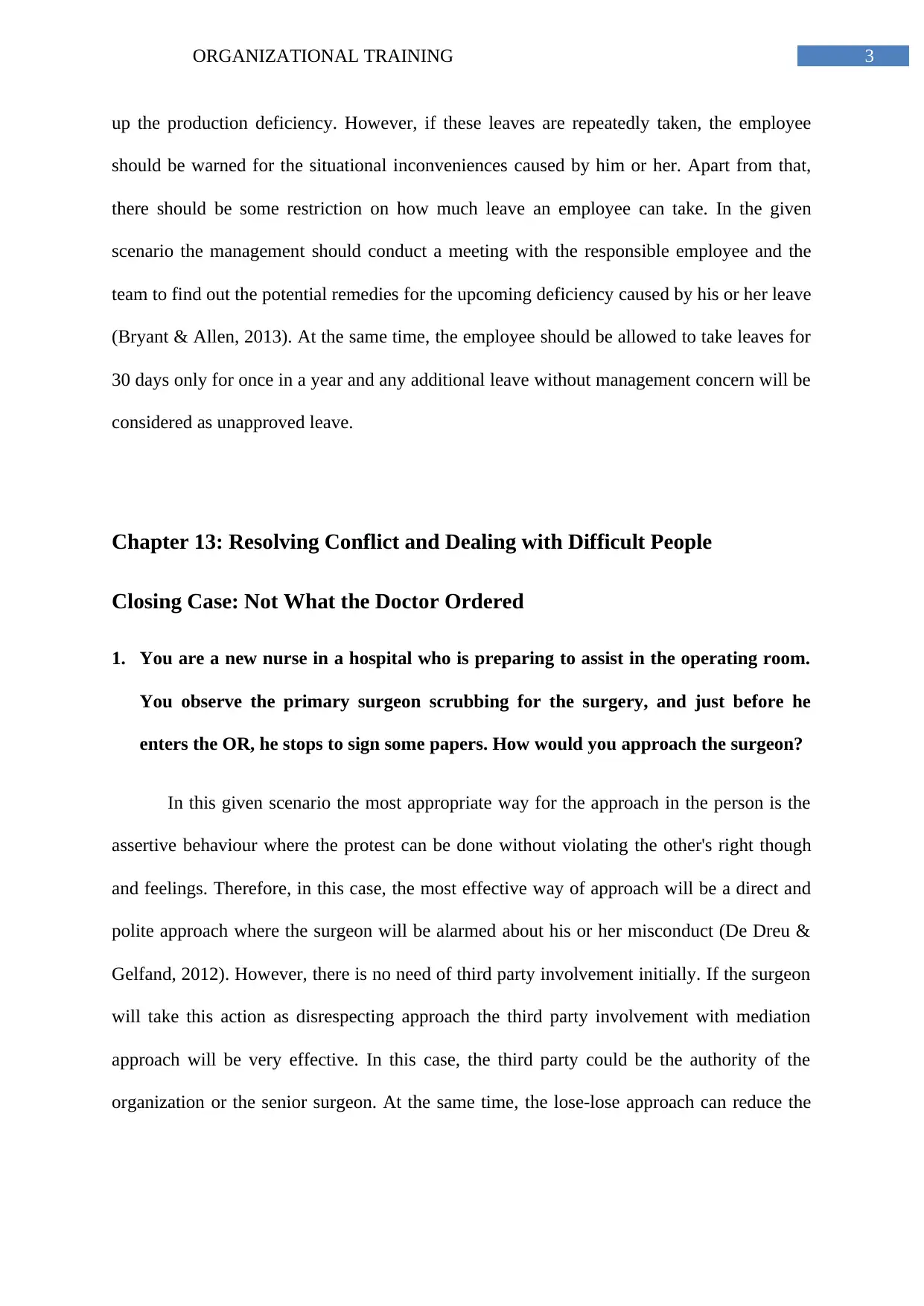
3ORGANIZATIONAL TRAINING
up the production deficiency. However, if these leaves are repeatedly taken, the employee
should be warned for the situational inconveniences caused by him or her. Apart from that,
there should be some restriction on how much leave an employee can take. In the given
scenario the management should conduct a meeting with the responsible employee and the
team to find out the potential remedies for the upcoming deficiency caused by his or her leave
(Bryant & Allen, 2013). At the same time, the employee should be allowed to take leaves for
30 days only for once in a year and any additional leave without management concern will be
considered as unapproved leave.
Chapter 13: Resolving Conflict and Dealing with Difficult People
Closing Case: Not What the Doctor Ordered
1. You are a new nurse in a hospital who is preparing to assist in the operating room.
You observe the primary surgeon scrubbing for the surgery, and just before he
enters the OR, he stops to sign some papers. How would you approach the surgeon?
In this given scenario the most appropriate way for the approach in the person is the
assertive behaviour where the protest can be done without violating the other's right though
and feelings. Therefore, in this case, the most effective way of approach will be a direct and
polite approach where the surgeon will be alarmed about his or her misconduct (De Dreu &
Gelfand, 2012). However, there is no need of third party involvement initially. If the surgeon
will take this action as disrespecting approach the third party involvement with mediation
approach will be very effective. In this case, the third party could be the authority of the
organization or the senior surgeon. At the same time, the lose-lose approach can reduce the
up the production deficiency. However, if these leaves are repeatedly taken, the employee
should be warned for the situational inconveniences caused by him or her. Apart from that,
there should be some restriction on how much leave an employee can take. In the given
scenario the management should conduct a meeting with the responsible employee and the
team to find out the potential remedies for the upcoming deficiency caused by his or her leave
(Bryant & Allen, 2013). At the same time, the employee should be allowed to take leaves for
30 days only for once in a year and any additional leave without management concern will be
considered as unapproved leave.
Chapter 13: Resolving Conflict and Dealing with Difficult People
Closing Case: Not What the Doctor Ordered
1. You are a new nurse in a hospital who is preparing to assist in the operating room.
You observe the primary surgeon scrubbing for the surgery, and just before he
enters the OR, he stops to sign some papers. How would you approach the surgeon?
In this given scenario the most appropriate way for the approach in the person is the
assertive behaviour where the protest can be done without violating the other's right though
and feelings. Therefore, in this case, the most effective way of approach will be a direct and
polite approach where the surgeon will be alarmed about his or her misconduct (De Dreu &
Gelfand, 2012). However, there is no need of third party involvement initially. If the surgeon
will take this action as disrespecting approach the third party involvement with mediation
approach will be very effective. In this case, the third party could be the authority of the
organization or the senior surgeon. At the same time, the lose-lose approach can reduce the
Secure Best Marks with AI Grader
Need help grading? Try our AI Grader for instant feedback on your assignments.
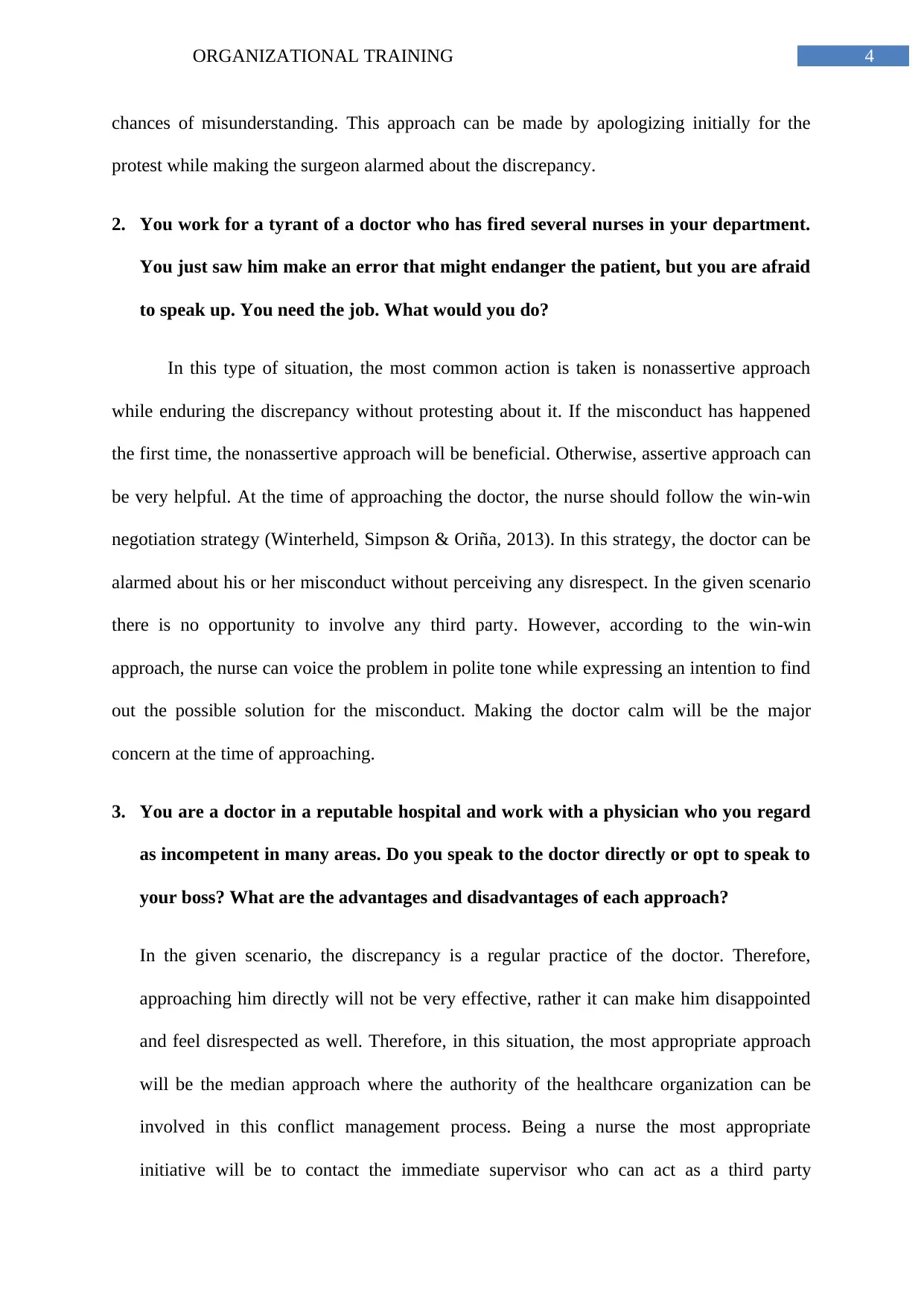
4ORGANIZATIONAL TRAINING
chances of misunderstanding. This approach can be made by apologizing initially for the
protest while making the surgeon alarmed about the discrepancy.
2. You work for a tyrant of a doctor who has fired several nurses in your department.
You just saw him make an error that might endanger the patient, but you are afraid
to speak up. You need the job. What would you do?
In this type of situation, the most common action is taken is nonassertive approach
while enduring the discrepancy without protesting about it. If the misconduct has happened
the first time, the nonassertive approach will be beneficial. Otherwise, assertive approach can
be very helpful. At the time of approaching the doctor, the nurse should follow the win-win
negotiation strategy (Winterheld, Simpson & Oriña, 2013). In this strategy, the doctor can be
alarmed about his or her misconduct without perceiving any disrespect. In the given scenario
there is no opportunity to involve any third party. However, according to the win-win
approach, the nurse can voice the problem in polite tone while expressing an intention to find
out the possible solution for the misconduct. Making the doctor calm will be the major
concern at the time of approaching.
3. You are a doctor in a reputable hospital and work with a physician who you regard
as incompetent in many areas. Do you speak to the doctor directly or opt to speak to
your boss? What are the advantages and disadvantages of each approach?
In the given scenario, the discrepancy is a regular practice of the doctor. Therefore,
approaching him directly will not be very effective, rather it can make him disappointed
and feel disrespected as well. Therefore, in this situation, the most appropriate approach
will be the median approach where the authority of the healthcare organization can be
involved in this conflict management process. Being a nurse the most appropriate
initiative will be to contact the immediate supervisor who can act as a third party
chances of misunderstanding. This approach can be made by apologizing initially for the
protest while making the surgeon alarmed about the discrepancy.
2. You work for a tyrant of a doctor who has fired several nurses in your department.
You just saw him make an error that might endanger the patient, but you are afraid
to speak up. You need the job. What would you do?
In this type of situation, the most common action is taken is nonassertive approach
while enduring the discrepancy without protesting about it. If the misconduct has happened
the first time, the nonassertive approach will be beneficial. Otherwise, assertive approach can
be very helpful. At the time of approaching the doctor, the nurse should follow the win-win
negotiation strategy (Winterheld, Simpson & Oriña, 2013). In this strategy, the doctor can be
alarmed about his or her misconduct without perceiving any disrespect. In the given scenario
there is no opportunity to involve any third party. However, according to the win-win
approach, the nurse can voice the problem in polite tone while expressing an intention to find
out the possible solution for the misconduct. Making the doctor calm will be the major
concern at the time of approaching.
3. You are a doctor in a reputable hospital and work with a physician who you regard
as incompetent in many areas. Do you speak to the doctor directly or opt to speak to
your boss? What are the advantages and disadvantages of each approach?
In the given scenario, the discrepancy is a regular practice of the doctor. Therefore,
approaching him directly will not be very effective, rather it can make him disappointed
and feel disrespected as well. Therefore, in this situation, the most appropriate approach
will be the median approach where the authority of the healthcare organization can be
involved in this conflict management process. Being a nurse the most appropriate
initiative will be to contact the immediate supervisor who can act as a third party
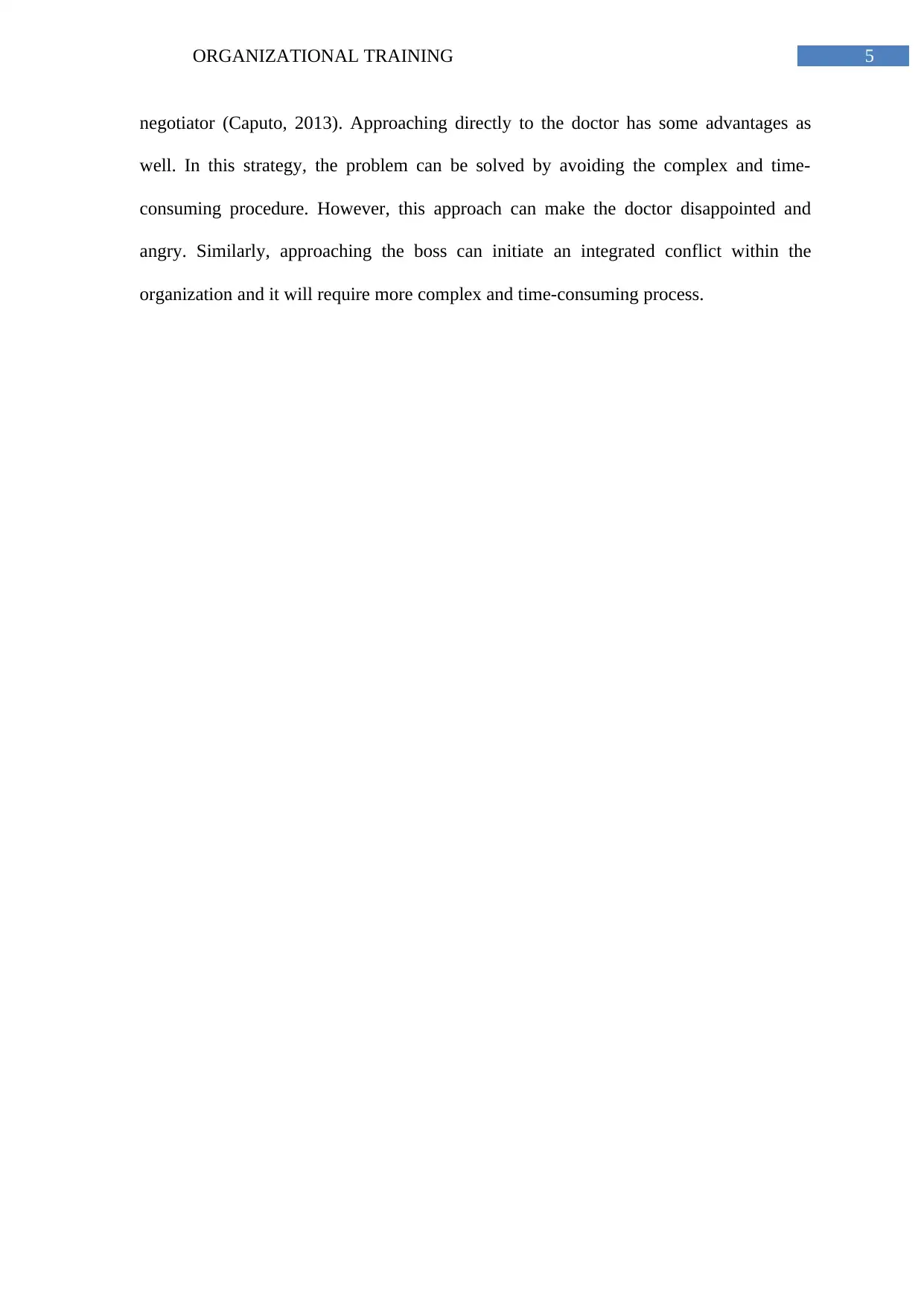
5ORGANIZATIONAL TRAINING
negotiator (Caputo, 2013). Approaching directly to the doctor has some advantages as
well. In this strategy, the problem can be solved by avoiding the complex and time-
consuming procedure. However, this approach can make the doctor disappointed and
angry. Similarly, approaching the boss can initiate an integrated conflict within the
organization and it will require more complex and time-consuming process.
negotiator (Caputo, 2013). Approaching directly to the doctor has some advantages as
well. In this strategy, the problem can be solved by avoiding the complex and time-
consuming procedure. However, this approach can make the doctor disappointed and
angry. Similarly, approaching the boss can initiate an integrated conflict within the
organization and it will require more complex and time-consuming process.

6ORGANIZATIONAL TRAINING
Reference
Bryant, P. C., & Allen, D. G. (2013). Compensation, benefits and employee turnover: HR
strategies for retaining top talent. Compensation & Benefits Review, 45(3), 171-175.
Caputo, A. (2013). A literature review of cognitive biases in negotiation
processes. International Journal of Conflict Management, 24(4), 374-398.
De Dreu, C. K., & Gelfand, M. J. (2012). Conflict in the Workplace: Sources, Functions, and
Dynamics Across Multiple Levels of Analysis: Carsten KW De Dreu and Michele J.
Gelfand. In The psychology of conflict and conflict management in organizations (pp.
23-74). Psychology Press.
King, R. B., Karuntzos, G., Casper, L. M., Moen, P., Davis, K. D., Berkman, L., ... & Kossek,
E. E. (2012). Work–family balance issues and work–leave policies. In Handbook of
occupational health and wellness (pp. 323-339). Springer, Boston, MA.
Kwenin, D. O., Muathe, S., & Nzulwa, R. (2013). The influence of employee rewards, human
resource policies and job satisfaction on the retention of employees in Vodafone
Ghana Limited. European Journal of Business and Management, 5(12), 13-20.
Winterheld, H. A., Simpson, J. A., & Oriña, M. M. (2013). It’s in the way that you use it:
Attachment and the dyadic nature of humor during conflict negotiation in romantic
couples. Personality and Social Psychology Bulletin, 39(4), 496-508.
Reference
Bryant, P. C., & Allen, D. G. (2013). Compensation, benefits and employee turnover: HR
strategies for retaining top talent. Compensation & Benefits Review, 45(3), 171-175.
Caputo, A. (2013). A literature review of cognitive biases in negotiation
processes. International Journal of Conflict Management, 24(4), 374-398.
De Dreu, C. K., & Gelfand, M. J. (2012). Conflict in the Workplace: Sources, Functions, and
Dynamics Across Multiple Levels of Analysis: Carsten KW De Dreu and Michele J.
Gelfand. In The psychology of conflict and conflict management in organizations (pp.
23-74). Psychology Press.
King, R. B., Karuntzos, G., Casper, L. M., Moen, P., Davis, K. D., Berkman, L., ... & Kossek,
E. E. (2012). Work–family balance issues and work–leave policies. In Handbook of
occupational health and wellness (pp. 323-339). Springer, Boston, MA.
Kwenin, D. O., Muathe, S., & Nzulwa, R. (2013). The influence of employee rewards, human
resource policies and job satisfaction on the retention of employees in Vodafone
Ghana Limited. European Journal of Business and Management, 5(12), 13-20.
Winterheld, H. A., Simpson, J. A., & Oriña, M. M. (2013). It’s in the way that you use it:
Attachment and the dyadic nature of humor during conflict negotiation in romantic
couples. Personality and Social Psychology Bulletin, 39(4), 496-508.
1 out of 7
Related Documents
Your All-in-One AI-Powered Toolkit for Academic Success.
+13062052269
info@desklib.com
Available 24*7 on WhatsApp / Email
![[object Object]](/_next/static/media/star-bottom.7253800d.svg)
Unlock your academic potential
© 2024 | Zucol Services PVT LTD | All rights reserved.




